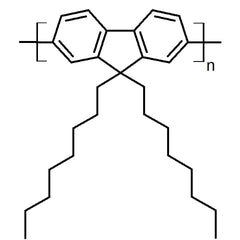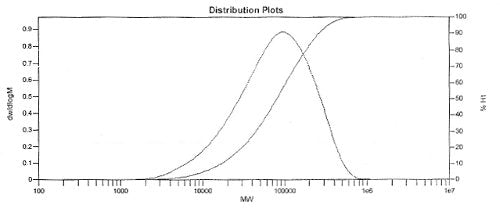Materials, OFET & OLED Polymer Materials, Perovskite Interface Materials, Perovskite Materials, Semi


Poly(9,9-di-n-octylfluorenyl-2,7-diyl), known as F8 or PFO, is a polyfluorene specifically optimized for a variety of organic electronic applications.
| CAS Number | 19456-48-5 |
|---|---|
| Chemical Formula | (C29H41)n |
| Full Name | Poly(9,9-di-n-octylfluorenyl-2,7-diyl) |
| Recommended solvents | Toluene, xylene, chlorobenzene |
| Synonyms |
F8 PFO |
| Classification / Family | Polyfluorenes, Benzothiodiazoles, Organic semiconducting materials, Semiconducting polymers, OLED green emitter materials, OLED materials, Organic photovoltaic (OPV) materials, Polymer solar cells, OFET materials |
 Chemical structure of PFO (F8). CAS No. 19456-48-5. Chemical formula: (C29H41)n.
Chemical structure of PFO (F8). CAS No. 19456-48-5. Chemical formula: (C29H41)n.
 F8 distribution plot
F8 distribution plot
For a high-efficiency green OLED we recommend blending F8 with F8BT with the below specifications. This ink can then be applied either in air, or in a glove box, with little difference in performance (provided exposure time and light levels are minimised). For more details see our fabrication guide.
At typical concentrations of 10 mg/ml, 100 mg of F8 (PFO) will make around 200 devices on Ossila's standard ITO substrates (20 x 15 mm), assuming 50% solution usage (50% loss in filtering and preparation).
OLED reference device:Pipetting 20 μl of the above solutions onto a substrate spinning at 2000 rpm should provide a good even coverage, with approximately 70 nm thickness. The substrate needs to be spun until dry, which is typically only a few seconds — 15 seconds should be ample to achieve this. Thermal annealing should be undertaken at 80°C for 10 minutes prior to cathode deposition.
A basic, efficient OLED can be made using PEDOT:PSS as a hole-transport layer and Calcium/Aluminum as the electron contact. When used with the Ossila ITO glass OLED substrates and shadow masks this produces an easy to fabricate yet efficient >100 cd/m2 device.
 Typical Ossila device architecture: Polyfluorene-based OLED architecture based on F8 blended with F8BT.
Typical Ossila device architecture: Polyfluorene-based OLED architecture based on F8 blended with F8BT.专业代理国外知名镊子品牌
我们将竭诚为你服务
0755-23003036